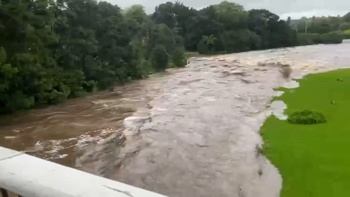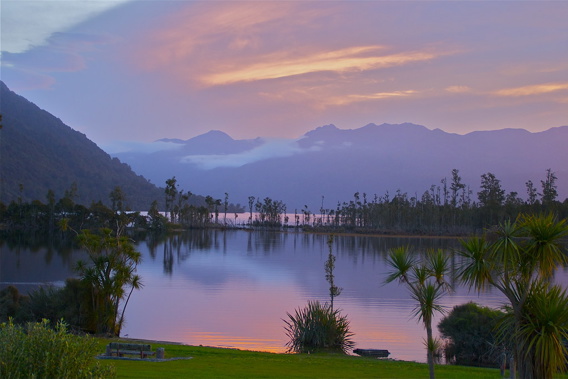
The West Coast’s Lake Brunner is the cradle for many happy family holiday memories for me. Maybe my warmly tinged sentiments make me somewhat biased, but I’d happily rate Brunner as one of New Zealand’s greatest lakeside escapes. Among many Coasters, they consider the brilliance of Lake Brunner as a cherished local secret. Gouged out by a branch of the Taramakau Glacier, the deep inky waters of the West Coast’s largest lake groan with wild brown trout, lending itself to year-round fishing. Most of the brown trout in this lake simply die of old age – or so the locals will tell you. Bracketed by unblemished views of the serrated peaks of the Southern Alps, those alpine vistas are sharply reflected in the lake’s dark and inky mirror surface.
Rest assured that ink-like appearance isn’t a sign of pollution, merely the presence of very high tannin levels, leached from leaves. If you like your water sports, Brunner purrs with possibilities. Jet boating, yachting, swimming kayaking and paddle-boarding all play out in this vast body of glass-clear water. The water can reach 25 degrees Celsius in summer because the 120-metre-deep lake is mountain fed, not snow fed. The tannin-stained darkness of the water helps absorb the solar heat.
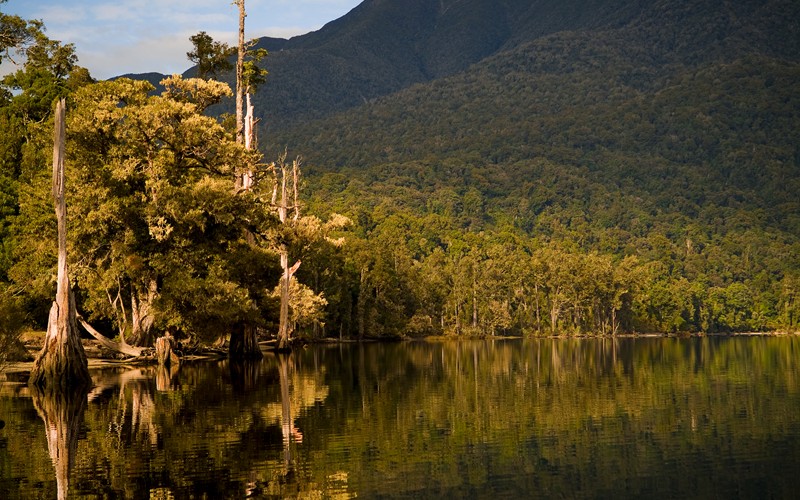 Tannin-stained waters of Lake Brunner. Photo / Supplied
Tannin-stained waters of Lake Brunner. Photo / Supplied
The lake is named in honour of the intrepid Thomas Brunner who, in 1848, became the first European to see the lake during his epic 550 day exploration of the region with Kehu and other indigenous guides. Brunner and Charles Heaphy both rated Kehu as the Māori guide extraordinaire, an exceptionally talented bushman and instinctive navigator, who was based in Motueka, and guided early European explorers across the wider West Coast, in search of good rural land. Kehu was enslaved by Ngāi Tahu at the age of 12 after they killed his father in an inter-tribal battle in 1810 on the West Coast. Brunner credited Kehu and his wife for saving his life, after he fell ill with paralysis on that mighty 18-month long expedition of the region south of the Buller River as far south as Haast. They remained lifelong friends.
The lakeside township of Moana is as cute-as-a-button, ensuring modern comforts are within ready reach, while enjoying a taste of the wild. The TranzAlpine calls into Moana to and from Greymouth, on its day-return excursions from Christchurch. There’s a stirring platter of trails slung around the lake, leading you deep into the heart of its podocarp forested grandeur, in addition to the wetlands and abundant birdlife. The track network is divided into the lake’s southern and northern sections, with the northern tracks starting from Moana. The 2km-long Lakeside Walk is a great introductory, threading its way around the pebble beach to the fabulous swing bridge across the Arnold River, which is the lake’s outfall.
The Velenski Walk is an even shorter track, starting just past the motorcamp, leading you to a lookout point with views of Orangipuku Valley, Mt Te Kinga and the Hohonu Range. The track ascends through regenerating bush to a ridge of original forest, cloaked in mature stands of rimu, miro and kahikatea. Another great option is the 30 minute return Rakaitane Track, which includes the Arnold River swingbridge. This walk is a botanical treasure with dramatic changes in the flora and fauna over a short period. At first it runs through kamahi forest and rises to a terrace covered in a regenerating forest of tall, slender kahikatea with dense mats of moss and fern adding to the charm. From a lofty viewpoint, the tranquil Arnold River is enrobed in a setting of massive miro and rimu trees. The track then loops back through more mature podocarp forest, with groves of tree ferns completing a winning sequence of botanical theatre.
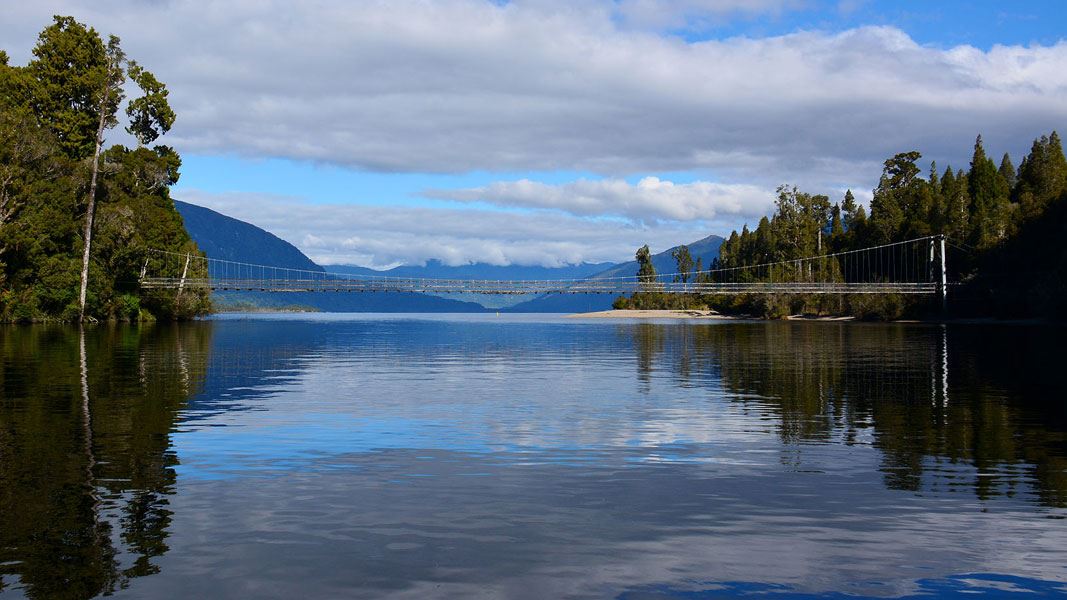 The Arnold River Swing Bridge. Photo / DOC
The Arnold River Swing Bridge. Photo / DOC
Currently under completion is the exciting new Lake Brunner Scenic Trail. This 15km track will link the town of Moana to the settlement of Mitchells at the southern end of Lake Brunner. Trail construction is now over the 11km mark and is available to walkers, runners, and cyclists. It has opened up a vast tract of the lake’s western shore that previously was only accessible by boat. Tireless work by passionate volunteers has powered the development of this wonderful new trail, which is due to be fully completed by Christmas.
Take the solitude-factor next-level and base yourself at Mitchells, at the southern end of the lake. It’s headlined by the one hour return walk to Carew Falls, right behind Lake Brunner Eco-Lodge. The Carew Creek waterfall has a year-round flow however in the late spring it’s spectacular with winter runoff. Enormous water sculptured granite boulders are sun warmed natural seats to relax and take in the views. The lake’s western edges can be viewed. Old pipes seen along the track are from a small hydro scheme that once provided power for the Mitchells Hotel (now Lake Brunner Eco-Lodge). At night, the first part of the track is wondrously twinkled with glowworms, shining through the native bush.
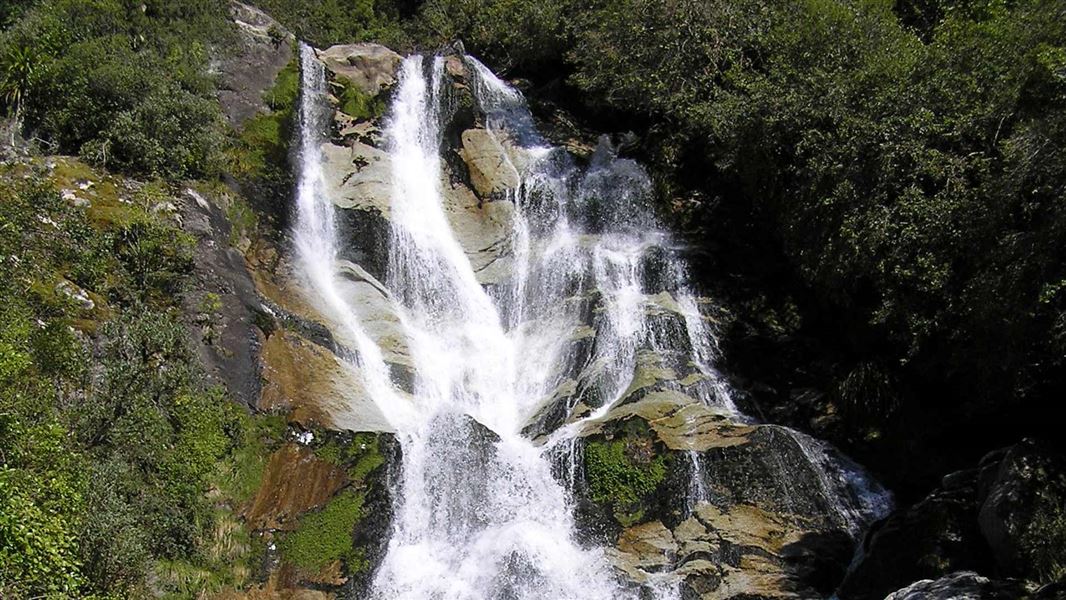 Carew Falls at Lake Brunner. Photo / DOC
Carew Falls at Lake Brunner. Photo / DOC
Nearby is the Bain Bay Walk. The full circuit is 7km long, but even doing a chunk of it will reward you handsomely. Before stepping out, check with the locals about the lake’s water level because it’s impassable at higher levels. The start of the track runs around the swampy lake margin mostly on boardwalk, with the option of walking on the lake beach in between. Both the track and boardwalk can be immersed and impassable when the lake level is running high. The track leads you into incredibly dense forest, studded with giant ancient trees including kahikatea, matai and rimu, along with tall tree ferns and tangles of vines to tantalise your inner-Tarzan. (Bain Bay Walk is currently partially closed due to erosion and removal of a damaged bridge. But the first part of the track is fine.)
Where to stay? Lake Brunner Eco-Lodge is a lakeside legend, beginning life in 1868 as Mitchell’s Hotel, rebuilt in the 1935 and recently refurbished. Brenda is your hearty host, who is always on-site to ensure your stay is extra-special. Celebrating its 90th anniversary next year, Lake Brunner Eco-Lodge boasts the classic architecture of yesteryear with the comforts and furnishings of today. You’ll love the roaring log fire, the book-lined library in warm wood panelling, and the games room with pool table. They’ve also got a private wood-fired hot tub, enrobed by native bush. Needless to say, with hardly any light pollution in these parts, the southern sky is all aglitter. Come nightfall, everything is so still. You could hear a pin drop as you gaze up in awe at the Milky Way.
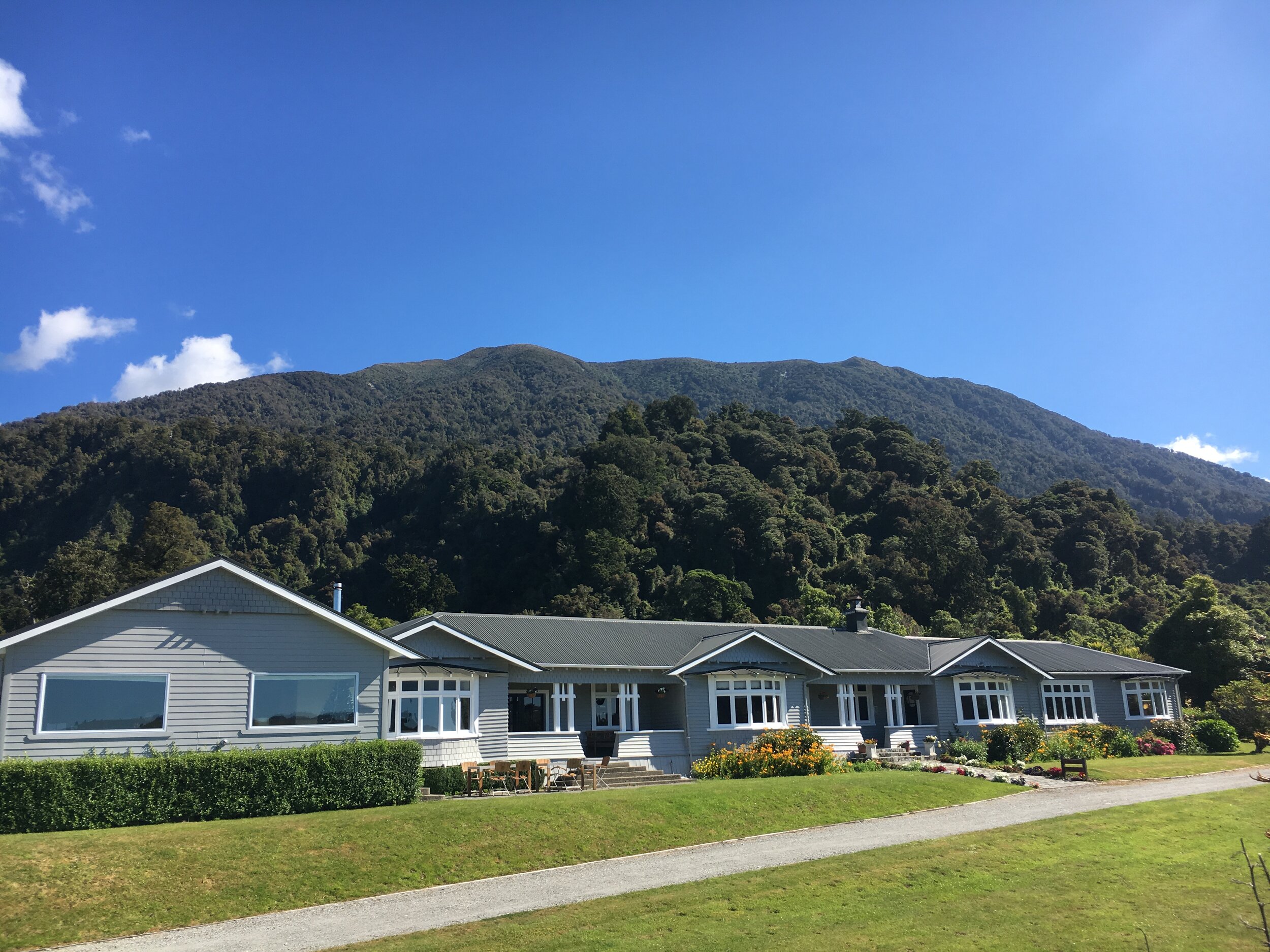 The Lake Brunner EcoLodge. Photo / Supplied
The Lake Brunner EcoLodge. Photo / Supplied
Comprising 8 ensuite rooms, you’ll be basking in luxurious lodge accommodation, graciously blending old world charm with contemporary comfort, wrapped in serene lakefront and forest scenery. I was serenaded to sleep by weka calls. The in-house bar and restaurant will ensure you never go hungry or thirsty. I had the most delicious monkfish, caught off the coast in the Tasman Sea, for dinner. The same water that drops from the nearby Carew Falls powers the lodge, via the Arnold River Dam. The lure of wide open spaces and wilderness escapes never goes out of fashion. Lake Brunner Eco-Lodge is a winning nature retreat to add to your bingo card. https://www.lakebrunner.co.nz/
Mike Yardley is our resident traveller on Jack Tame Saturday Mornings.
Take your Radio, Podcasts and Music with you






